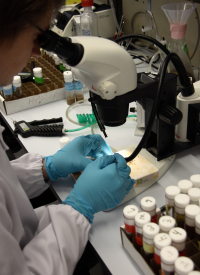 NOTÍCIES
NOTÍCIES
Sex matters
Researchers from the Centre for Genomic Regulation (CRG) are investigating how the process of dosage compensation in sex chromosomes is regulated. Their discoveries have just been published in two articles in the prestigious scientific journals Nature and Nature Communications. Both articles help us understand the relationships between important molecules with consequences for the expression of X-linked genes, and serve to vindicate the importance of sex in gene expression and, therefore, its relevance to biomedical research.
In many species, males and females have different sex chromosomes. For example, female humans have XX and men have XY chromosomes. Researchers from the Centre for Genomic Regulation have been studying how cells try to compensate for this difference in chromosomal content so that both males and females maintain basic cell functionality and are not affected by duplicate X chromosome genes (in the case of women) or because they have one less X chromosome (in the case of men).
Researcher Fátima Gebauer and her team at the CRG carried out their work on the fruit fly, Drosophila melanogaster. The scientists, in collaboration with other laboratories in Germany (led by Dr Sattler from Technische Universität and Dr Becker at Ludwig Maximilians Universität, both in Munich) report a protein that has opposite roles in dosage compensation, depending on sex. In the case of females, the protein represses the machinery that carries dosage compensation in sex chromosomes. In contrast, in males, the same protein promotes the dosage compensation machinery. In this way, even if the initial dosage of genetic material for each sex is different, both sexes express genes located on X chromosomes at equal levels.
“Studying this mechanism has allowed us to find out more about the protein UNR. We have been able to determine how UNR functions in both sexes in relation to dosage compensation, and have also uncovered a new type of molecular interaction (between proteins and RNA) that may operate in other biological contexts”, explains Fátima Gebauer, head of the Regulation of Protein Synthesis group at the Centre for Genomic Regulation in Barcelona.
The two studies represent an important contribution to basic biomedical research. On the one hand, they have clarified a gene regulatory mechanism, in this case, related to dosage compensation and gender, and on the other, they have described a new form of binding between proteins and RNA which offers a whole range of new possibilities for gene regulation.
In addition, the work highlights the importance of sex in controlling gene expression and vindicates the consideration of gender in biomedical research. “Observing these compensatory mechanisms and understanding the differences in gene regulation between males and females, we must reiterate the importance of gender in scientific studies. We clearly see that it is just not the same to study the activity of a gene in a male compared to a female, even when it comes to genes that are not related to sex, and often researchers do not take this into account”, adds Dr Gebauer.
References:
- Hennig J, Militti C, Popowicz GM, Wang I, Sonntag M, Geerlof A, Gabel F, Gebauer F & Sattler M. Structural basis for the assembly of the Sxl-Unr translation regulatory complex. Nature 2014 Nov 13;515(7526):287-90. doi: 10.1038/nature13693. Epub 2014 Sep 7.
- Militti C, Maenner S, Becker PB, Gebauer F. UNR facilitates the interaction of MLE with the lncRNA roX2 during Drosophila dosage compensation. Nat Commun. 2014 Aug 27;5:4762. doi: 10.1038/ncomms5762.

